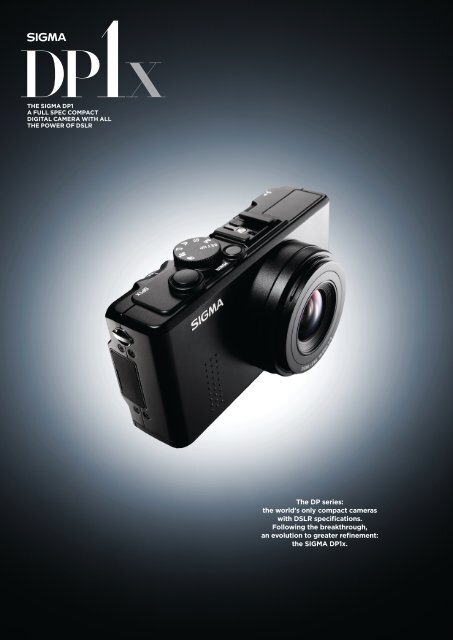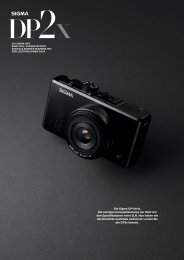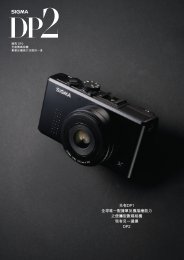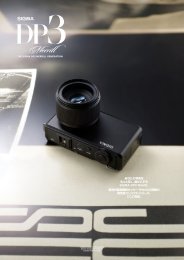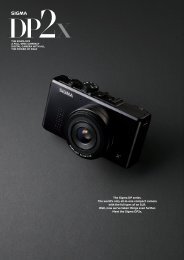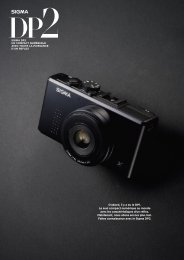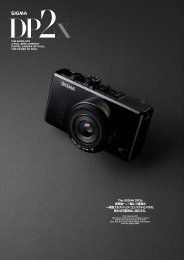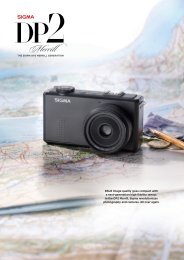The DP series: the world's only compact cameras with ... - SIGMA DP
The DP series: the world's only compact cameras with ... - SIGMA DP
The DP series: the world's only compact cameras with ... - SIGMA DP
Create successful ePaper yourself
Turn your PDF publications into a flip-book with our unique Google optimized e-Paper software.
<strong>The</strong> <strong>DP</strong> <strong>series</strong>:<strong>the</strong> <strong>world's</strong> <strong>only</strong> <strong>compact</strong> <strong>cameras</strong><strong>with</strong> DSLR specifications.Following <strong>the</strong> breakthrough,an evolution to greater refinement:<strong>the</strong> <strong>SIGMA</strong> <strong>DP</strong>1x.
Trust your eye. Trust your hand,<strong>The</strong>y know a good camera.Sigma's <strong>DP</strong> <strong>cameras</strong> treat light and color <strong>with</strong> due respect.<strong>The</strong>y don't change any of it. <strong>The</strong>y don't lose any of it.<strong>The</strong> result? An amazing capacity to capture fine detail.Unleash your creativity.Let your inner photographer see things in a new way.Do it all <strong>with</strong> this <strong>compact</strong> body.We believe in photographing things as <strong>the</strong>y really are.This shapes our concept of <strong>the</strong> way a camera should be.With <strong>the</strong> <strong>DP</strong> <strong>series</strong>, we're aiming to recapture <strong>the</strong> essence of <strong>the</strong> camera.<strong>The</strong> <strong>DP</strong>1 that launched this initiative has now been reborn.You remember <strong>the</strong> <strong>DP</strong>1? <strong>The</strong> little camera that could?It blew existing image-quality standards out of <strong>the</strong> water.It opened up new horizons for amateur photographers.And now it's even better.<strong>The</strong> <strong>SIGMA</strong> <strong>DP</strong>1x.For <strong>the</strong> photographer who wants to capture genuine emotion.02This photograph shows <strong>the</strong> approximate dimensions of <strong>the</strong> Sigma <strong>DP</strong>1x.
Camera : <strong>SIGMA</strong> <strong>DP</strong>1x, File Type: X3F Raw, Exposure Mode: Aperture Priority AE, ISO Setting : 100, White Balance : Auto, Shutter Speed : 1/80s, Aperture Value : F4.0, Focal Length: 16.6 mm 03
04Camera : <strong>SIGMA</strong> <strong>DP</strong>1x, File Type: X3F Raw, Exposure Mode: Aperture Priority AE, ISO Setting : 100, White Balance : Auto, Shutter Speed : 1 sec, Aperture Value : F4.0, Focal Length: 16.6 mm
<strong>The</strong> revolution has gained refinement.<strong>The</strong> <strong>world's</strong> first full-spec <strong>compact</strong>“A large sensor in a <strong>compact</strong> body.” Appearingall over <strong>the</strong> media, this phrase neatly summedup Sigma's <strong>DP</strong> <strong>series</strong> of high-performance, highimage-quality <strong>compact</strong> <strong>cameras</strong>.Ever since digital <strong>cameras</strong> ousted film <strong>cameras</strong>from <strong>the</strong>ir mainstream status, <strong>the</strong> image sensorsused in <strong>compact</strong> <strong>cameras</strong> had been far smallerthan those used in SLRs. Of course, photosensor size plays a crucial role in determiningimage quality. This was true in <strong>the</strong> days offilm, and it's just as true in <strong>the</strong> digital age. Yet<strong>compact</strong> <strong>cameras</strong> had been getting steadilysmaller and lighter. Meanwhile, <strong>the</strong> all-importantpursuit of higher image quality had becomean afterthought, for reasons of cost andtechnological difficulties.What's more, digital <strong>compact</strong>s were all aboutextra functions and more megapixels. Higherpixel-counts were achieved simply by making<strong>the</strong> pixels extremely small, so that more of<strong>the</strong>m could be crammed in, while <strong>the</strong> sensoritself remained as small as ever. In terms of<strong>the</strong> essence of photographic expression, pixelcounts don't really count. Yet competition onthis front had reached fever pitch by <strong>the</strong> springof 2008, when <strong>the</strong> Sigma <strong>DP</strong>1 made its longawaiteddebut.<strong>The</strong> <strong>DP</strong>1 opened up new horizons<strong>The</strong> <strong>DP</strong>1 was introduced as a <strong>compact</strong> digitalcamera <strong>with</strong> an SLR-sized image sensor. It wasa camera that satisfied <strong>the</strong> artist's need for topimage quality and yet was <strong>compact</strong> enoughto take anywhere. This had always been <strong>the</strong>amateur photographer's dream. And a dreamit remained, until Sigma boldly took up <strong>the</strong>challenge and overcame numerous challengesto make it happen.That glimpse of unexpected beauty on yourdaily commute, early in <strong>the</strong> morning or latein <strong>the</strong> evening. <strong>The</strong> subtlety of human dramaencountered on a street corner. <strong>The</strong> dewy petalof a nameless roadside flower. As anyone wholoves photography could tell you, those crucialmoments can't be contrived. <strong>The</strong>re's <strong>only</strong> oneplace you find <strong>the</strong>m: <strong>the</strong> often overlookedcorners of ordinary life.At Sigma, we have strong views about whata camera should be. Sensor size isn't our <strong>only</strong>obsession: we're also big on pioneering sensordesign. That's why our <strong>DP</strong> <strong>cameras</strong> feature <strong>the</strong>Foveon X3® direct image sensor, which breaksnew ground by capturing <strong>the</strong> full complementof colors at each individual pixel location.Thanks to this sensor, our <strong>DP</strong> <strong>cameras</strong> producedistinctive images that combine exquisitevividness <strong>with</strong> astonishingly high definition,outclassing conventional digital image quality.Thanks to <strong>the</strong> unique 3-D feel plus <strong>the</strong> clarityand sharpness, delivered by Sigma's proprietarythree-layered Foveon X3® direct image sensor,<strong>the</strong> images created by <strong>the</strong> <strong>DP</strong>1 won acclaim fromphotographers all over <strong>the</strong> world. <strong>The</strong>ir imagequality was compared to that of a mediumformatfilm camera ra<strong>the</strong>r than that of a DSLR.<strong>The</strong> rest is recent history: <strong>the</strong> <strong>DP</strong>1's formidabledescriptive power not <strong>only</strong> made a worldwidesplash, but also transcended <strong>the</strong> existingdistinction between SLRs and <strong>compact</strong>s,creating <strong>the</strong> new “full-spec <strong>compact</strong>” category.<strong>The</strong>re's just no doubt about it—<strong>the</strong> <strong>DP</strong>1 createdquite a buzz in photographic circles.Sigma's photographic passion and principlesYou wouldn't carry an SLR around unless youintended to shoot some serious photos. Picturestaken <strong>with</strong> an SLR have to be carefully set up,framed and posed. All sorts of complicatedsettings have to be fiddled <strong>with</strong>. That'show most people would think of an SLR.Yet Sigma took <strong>the</strong> essence of an SLR, andpacked it, unabridged, into a <strong>compact</strong> body.We also included a generous dollop of extrahigh-performance functions. We gave <strong>the</strong>photographer more artistic control, and leftmore scope for creative expression.With <strong>the</strong> introduction of <strong>the</strong> Sigma <strong>DP</strong> <strong>series</strong>,serious photography can now be part ofyour everyday routine. And that's not all:<strong>the</strong>se <strong>cameras</strong> are <strong>the</strong> perfect fit for today'sincreasingly nonconformist, free-spiritedusers. <strong>The</strong>y awaken <strong>the</strong> creativity <strong>with</strong>in manyphotographers, often causing <strong>the</strong>m to fall inlove <strong>with</strong> photography all over again.In its forms and workflows, photographicequipment changes <strong>with</strong> <strong>the</strong> times.Photographic expression is also subject topassing trends. What stays unchanged is<strong>the</strong> way a camera should be. A camera shouldslavishly follow your direction. It should respectyour intention. And it should do this <strong>with</strong>outlosing sight of <strong>the</strong> essence of photography,namely, capturing your own personal sensoryexperience, <strong>the</strong> picture in your mind's eye—a single image <strong>only</strong> you could create.This is <strong>the</strong> fundamental concept underlying allof Sigma's evolving technological innovation.05
A Camera that Transforms Your PerceptionAfter <strong>the</strong> ground-breaking,<strong>the</strong> fine-tuning<strong>The</strong> <strong>DP</strong>1 was <strong>the</strong> <strong>world's</strong> first truly fullspec <strong>compact</strong> camera. It deserves tobe remembered as <strong>the</strong> camera thatlaunched Sigma's <strong>DP</strong> <strong>series</strong>. This trulyhigh-performance <strong>compact</strong> camerawas groundbreaking in that it featuredan SLR-sized image sensor. However,precisely because it was so groundbreaking,it faced some challenges.At Sigma, we believe that users shouldexperience <strong>the</strong> joy of finessing <strong>the</strong>irpictures, working <strong>with</strong> superb imagequality. In line <strong>with</strong> this philosophy, wegave <strong>the</strong> <strong>DP</strong>1 a specification worthyof an SLR, based on RAW (X3 mode)output. We wanted to create a wholenew <strong>DP</strong> world of our own. But wemust admit that, as an instrument fortaking photos, <strong>the</strong> <strong>DP</strong>1 was more of abreakthrough than a culmination.We must also concede that <strong>the</strong> TRUE<strong>the</strong> first-generation image-processingengine featured in <strong>the</strong> <strong>DP</strong>1–processed<strong>the</strong> abundant image data outputby <strong>the</strong> Foveon X3® direct imagesensor at a speed that some foundunsatisfactory. <strong>The</strong> <strong>DP</strong>1's earlyadopters may well have felt <strong>the</strong> needfor enhancement.A more highly evolvedversion of <strong>the</strong> <strong>DP</strong>1<strong>The</strong> concept behind <strong>the</strong> <strong>DP</strong>1—<strong>the</strong> firstgeneration model remains unchangedin <strong>the</strong> <strong>DP</strong>1x. <strong>The</strong> new camera features<strong>the</strong> Foveon X3® direct image sensor,which provides astonishing definition,said to be on a par <strong>with</strong> that of mediumformat film. It also uses a speciallydesigned ultra high-performancewide-angle lens equivalent to 28mmin a 35mm camera, which is evenbetter than many high-performanceinterchangeable lenses used in SLRs.We wanted <strong>the</strong> <strong>DP</strong>1x to deliver <strong>the</strong>special 3-D feel and texture that are<strong>the</strong> raison d'être of <strong>the</strong> <strong>DP</strong> <strong>series</strong>. That'swhy, ra<strong>the</strong>r than concentrating on asingle index such as MTF, we aimedfor all-round lens performance. As forimage texture, which is determined bydifferences in focal length, F-numberand o<strong>the</strong>r parameters, we took care tomake <strong>the</strong> <strong>DP</strong>1x consistent <strong>with</strong> <strong>the</strong> restof <strong>the</strong> <strong>DP</strong> <strong>series</strong>.We also endowed <strong>the</strong> <strong>DP</strong>1x <strong>with</strong> <strong>the</strong>highly-acclaimed user interface and<strong>the</strong> TRUE II second-generation imageprocessing engine used in <strong>the</strong> <strong>DP</strong>2—<strong>the</strong>second release in <strong>the</strong> <strong>DP</strong> <strong>series</strong>. Withmore intuitive controls and dramaticallyimproved operability and processingspeeds, <strong>the</strong> <strong>DP</strong>1x is a more highlyevolvedphotographic instrument.<strong>The</strong> pleasures of perspective<strong>The</strong> <strong>DP</strong>1x has an integral wide-anglelens equivalent to 28mm in a 35mmcamera. Since its field angle is greaterthan that of <strong>the</strong> human eye, a wideanglelens can be used to bring outperspective, adding dynamism anddrama to your photographs.This type of lens really comes intoits own when shooting landscapesand buildings, where its distinctiveperspective can be used to fulladvantage. It allows dynamic capturesof clear blue skies, white fluffy cloudsand deep crimson sunsets. Buildings,be <strong>the</strong>y historical structures, stylishexamples of modern architecture, oranything in between, can be cleverlyframed for maximum interest, orcaptured in a thousand o<strong>the</strong>r cool ways.Breathing new inspiration intoyour photographic art<strong>The</strong> wide-angle lens is also greatfor snapshots. For one thing, it hastechnical advantages—it's lesssusceptible to camera-shake andallows a greater depth of field. Forano<strong>the</strong>r, its wide field angle gives youan edge when it comes to capturingsubtle human interactions, or snatchingthat rare and unexpected photogenicmoment that can show up in <strong>the</strong> mostbanal of everyday scenes.Portraits are ano<strong>the</strong>r genre you reallyshould try <strong>with</strong> <strong>the</strong> wide-angle lens on<strong>the</strong> <strong>DP</strong>1x. <strong>The</strong> telephoto lensis <strong>the</strong> mainstream choice for thistype of shot, so using a wide-anglelens adds a fresh twist right away.For a classic headshot, use portrait(vertical) orientation. Whe<strong>the</strong>r youshoot in portrait or landscape, you caninject a sense of depth and a dash ofdrama by cleverly incorporating <strong>the</strong>existing background, or by arrangingbackground objects yourself.Most photographers start out <strong>with</strong>an interest in using telephoto lenses.An obsession <strong>with</strong> wide-angle lensestends to follow later. What gets <strong>the</strong>mhooked on <strong>the</strong> wide-angle lens is itsversatility and its infinite potential forartistic expression. This type of lensbrings all sorts of extraneous objectsinto <strong>the</strong> frame, so it can be trickyto master. <strong>The</strong> effort is more thanrepaid, however, by <strong>the</strong> extra scopefor dramatic staging. In terms of sheerartistic enjoyment, <strong>the</strong> wide-angle lensgets more and more rewarding as yougo up <strong>the</strong> learning curve.A lens that takes you back to basicsLike <strong>the</strong> o<strong>the</strong>r Sigma <strong>DP</strong> <strong>cameras</strong>,<strong>the</strong> <strong>DP</strong>1x uses a single-focus lens. Ashigh-performance zoom lenses havebecome mainstream even in integrallens<strong>cameras</strong>, this might seem anunusual choice.Certainly, when you can <strong>only</strong>shoot from a certain spot, a highmagnificationzoom lens is hardto beat: its extensive visual fieldconveniently covers <strong>the</strong> range fromwide-angle to telephoto. If you'veever struggled to take pictures <strong>with</strong> asingle-focus lens that has <strong>the</strong> wrongfield angle, you'll know just howfrustrating it can be.And yet, <strong>the</strong> single-focus lens has anelegance all of its own. Give it someserious attention, and it will repay<strong>the</strong> favor by taking you right back to<strong>the</strong> basics of photography. Choosing<strong>the</strong> subject. Finding <strong>the</strong> best angle.Framing <strong>the</strong> shot in <strong>the</strong> best waypossible. Considering <strong>the</strong> light andshadow falling on <strong>the</strong> subject. Takingaccount of <strong>the</strong> colors. This is whatphotography is all about. In Sigma'sphilosophy, <strong>the</strong>re's <strong>only</strong> one way totake a picture that is truly your own.You have to establish your personal,subjective relationship <strong>with</strong> <strong>the</strong>subject. And that means making all<strong>the</strong> artistic decisions yourself.A camera thattrains your artistic eyeShooting <strong>with</strong> a single-focus lensforces you to frame <strong>the</strong> shot bymoving your physical position. Witha camera that automatically selects<strong>the</strong> best field angle for <strong>the</strong> subject,it wouldn't really matter where youpositioned yourself. With a singlefocuslens, however, actively searchingfor <strong>the</strong> best way to frame <strong>the</strong> shotmakes you rethink your old habits.This prompts you to re-establish anew, more au<strong>the</strong>ntic, more personalrelationship <strong>with</strong> photography.Rediscover <strong>the</strong> joy of photography.Unleash your inner artist <strong>with</strong> <strong>the</strong> <strong>DP</strong>1x.06
Camera : <strong>SIGMA</strong> <strong>DP</strong>1x, File Type: X3F Raw, Exposure Mode: Aperture Priority AE, ISO Setting : 100, White Balance : Auto, Shutter Speed : 1/80s, Aperture Value : F4.0, Focal Length: 16.6 mm 07
<strong>The</strong> <strong>DP</strong>1x's Foveon X3® directimage sensor utilizes <strong>the</strong>special features of silicon,which is penetrated todifferent depths by differentwavelengths of light, tosuccessfully achieve full-colorcapture for <strong>the</strong> first time everin a single-chip configuration.No color filter is required.Since <strong>the</strong> X3 can capture all <strong>the</strong>color information in its threelayers, <strong>the</strong> aforementionedlate-stage color interpolationnecessitated by <strong>the</strong> Bayer filterimage-sensor is not required,and exquisite, nuanced colorexpression can be created inpixel-location units. Compared<strong>with</strong> <strong>the</strong> color-fudging Bayerfilter image sensor, <strong>the</strong> X3takes color resolution to anew and truly amazing level.Since it does not need a colorfilter, <strong>the</strong> direct image sensordoes not generate colorartefacts. This, of course,means that no optical lowpassfilter is needed ei<strong>the</strong>r.This full-color capture systemcan cope <strong>with</strong> all kinds ofhigh-frequency areas, andcapture <strong>the</strong> full complementof colors. That's why <strong>the</strong>results are both absolutelynatural and truly exquisite.R: 100% G: 100% B: 100% R: 25% G: 50% B: 25%<strong>The</strong> Foveon X3® Sensor<strong>The</strong> Foveon X3® has three layers ofphotosensors, enabling it to capture 100%of <strong>the</strong> RGB color data at once.<strong>The</strong> Bayer filter Image Sensor<strong>The</strong> old-fashioned Bayer filter image sensorcan <strong>only</strong> capture 50% of <strong>the</strong> green color data,and a mere 25% each of <strong>the</strong> blue and <strong>the</strong> red.08
<strong>The</strong> Fine Art of Capturing DetailConventional digital <strong>cameras</strong> usemonochrome sensorsYou might be surprised to learn that<strong>the</strong> sensors in most digital <strong>cameras</strong>on <strong>the</strong> market, apart from Sigma'sSD and <strong>DP</strong> <strong>series</strong>, are basicallymonochrome. Because monochromesensors do not capture color data, acolor filter <strong>with</strong> a mosaic of pixels for<strong>the</strong> three primary colors — red, blueand green (RGB) — is mounted on topso that color data can be represented.But each light-sensing photodiodehas a one-color filter, which meansthat each pixel can <strong>only</strong> capture onecolor, and data for <strong>the</strong> o<strong>the</strong>r twocolors is discarded.Until this stage, of course, as in<strong>the</strong> Autochrome process, <strong>the</strong> RGBcolor “particles”, or pixels, arerecorded unmodified, forming <strong>the</strong>photo. A color interpolation processknown as demosaicing is <strong>the</strong>reforeperformed in <strong>the</strong> latter stage of <strong>the</strong>image processing, and this restores<strong>the</strong> colors lost by individual pixels.This interpolation process basicallyconsists of guessing <strong>the</strong> missingcolors from <strong>the</strong> neighboring pixels,and adding <strong>the</strong>m back in.Post-processing <strong>the</strong> imageleads to a loss of detailHaving been continuously improvedover an extended period, this imageprocessingmethod has maturedto a certain extent, so <strong>the</strong> colorinterpolation is now performedfairly accurately. But because colorsare interpolated from neighboringpixels, <strong>the</strong> subtle color nuances of <strong>the</strong>original subject are lost.Conventional digital <strong>cameras</strong> usingcolor filter arrays also generatecolor artifacts – colors not foundin <strong>the</strong> original subject – during <strong>the</strong>demosaicing processing. This isdue to <strong>the</strong> action of <strong>the</strong> color filter(generally a Bayer filter), which triesto regulate <strong>the</strong> color distribution if<strong>the</strong> subject contains too much detail(high-frequency areas).A conventional digital camera usinga Bayer color filter has yet ano<strong>the</strong>rfilter, known as an optical low-passfilter, interposed between <strong>the</strong> lensand <strong>the</strong> sensor, in order to suppresscolor artifacts. <strong>The</strong> optical low-passfilter acts on <strong>the</strong> images resolved ata high level by <strong>the</strong> imaging lens, itsjob being to eliminate any detailedelements likely to generate colorartifacts (high-frequency areas abovea certain level), immediately before<strong>the</strong>y reach <strong>the</strong> sensor. So it caneffectively suppress <strong>the</strong> generationof color artifacts, but <strong>the</strong> downside isthat it naturally reduces <strong>the</strong> resolutionof <strong>the</strong> image.<strong>The</strong> Foveon X3® captures <strong>the</strong>very feeling in <strong>the</strong> air.Images produced by Sigma's SDand <strong>DP</strong> <strong>series</strong> <strong>cameras</strong> have what'sbeen called an “emotional quality”.This phrase expresses <strong>the</strong> distinctiveimage-quality you <strong>only</strong> get <strong>with</strong> <strong>the</strong>Foveon X3® direct image sensor.In terms of clarity and fine detail, itgoes far beyond <strong>the</strong> capabilities ofconventional digital <strong>cameras</strong>. Thislevel of image quality reproduces <strong>the</strong>scene you shot, right down to <strong>the</strong>feeling in <strong>the</strong> air. It's <strong>only</strong> possible ina vertical color-capture system thatdoes not require color interpolation,and an image-processing systemthat does not require an opticallow-pass filter.A conventional image-sensor, on<strong>the</strong> o<strong>the</strong>r hand, fudges <strong>the</strong> colors,and even cuts out high-frequencyareas. To compensate, <strong>the</strong> sharpnessprocessing is ramped up to givesome overall nuancing and a generalimpression of high resolution. Thisexplains <strong>the</strong> tendency to generateimages that, as a whole, have anunnatural feel. <strong>The</strong> colors can beadjusted to some extent in postprocessing,but <strong>the</strong> detailed datapreviously lost cannot be recovered.No wonder <strong>the</strong> images produced byconventional digital <strong>cameras</strong>, despite<strong>the</strong>ir emphasized edges and clevernuancing, look so unnatural, so subtlywrong, It's all about basic principles.A sensor that discards none of <strong>the</strong>original light and color. And addsnone ei<strong>the</strong>r.<strong>The</strong> <strong>DP</strong>1x's Foveon X3® direct imagesensor utilizes <strong>the</strong> special features ofsilicon, which is penetrated to differentdepths by different wavelengths oflight, to successfully achieve fullcolorcapture for <strong>the</strong> first time ever ina single-chip configuration. No colorfilter is required. Like modern colorfilm <strong>cameras</strong>, it uses a method thatcaptures all <strong>the</strong> colors vertically.Because it does not need colorinterpolation or a low-pass filter, <strong>the</strong>X3 image sensor produces imagesthat are sharp right from <strong>the</strong> start.<strong>The</strong>refore, sharpness processing in <strong>the</strong>latter stages of <strong>the</strong> image processing– creating edges and emphasizingcontours – can be reduced to aminimum. This is why reviewers haveevaluated <strong>the</strong> images captured by<strong>the</strong> X3 image sensor as having a trulynuanced, sharp feel, and praised <strong>the</strong>mas very natural and demonstratingsuperior image quality.<strong>The</strong> Foveon X3® direct image sensorreproduces pure, rich data andnothing else. <strong>The</strong> image quality itdelivers is breathtaking. You reallyneed to see it for yourself.09
Camera : <strong>SIGMA</strong> <strong>DP</strong>1x, File Type: X3F Raw, Exposure Mode: Aperture Priority AE, ISO Setting : 100, White Balance : Auto, Shutter Speed : 1/4s, Aperture Value : F8, Focal Length: 16.6 mm 11
12Camera : <strong>SIGMA</strong> <strong>DP</strong>1x, File Type: X3F Raw, Exposure Mode: Aperture Priority AE, ISO Setting : 100, White Balance : Auto, Shutter Speed : 1.6s, Aperture Value : F8, Focal Length: 16.6 mm
14Camera : <strong>SIGMA</strong> <strong>DP</strong>1x + Close-up Lens AML-1, File Type: X3F Raw, Exposure Mode: Aperture Priority AE, ISO Setting : 200, White Balance : Auto, Shutter Speed : 1/60s, Aperture Value : F4, Focal Length: 16.6 mm
Bigger Sensor — Better Image QualityFilm or digital: big photoreceptorsmean high image quality.<strong>The</strong> bigger <strong>the</strong> film size, <strong>the</strong> better<strong>the</strong> image quality. That's commonknowledge in <strong>the</strong> world of film<strong>cameras</strong>. Even so, caught up in <strong>the</strong>powerful tide of digitization, and <strong>the</strong>feverish, single-minded competition toachieve <strong>the</strong> highest pixel count, mostcamera manufacturers seem to havelost sight of this obvious fact sometime ago. Ever tried using a Browniefilm camera to shoot high-qualityphotos? <strong>The</strong>n you'll have a vivid senseof <strong>the</strong> exponential increase in imagequality as film size increases. Basically,<strong>the</strong> same goes for digital <strong>cameras</strong>. Ino<strong>the</strong>r words, sensor performance beingequal, <strong>the</strong> image quality of a digitalcamera is determined by <strong>the</strong> size of<strong>the</strong> image sensor, be it CCD, CMOS orany o<strong>the</strong>r type.In <strong>the</strong> era of film <strong>cameras</strong>, both SLRsand <strong>compact</strong>s using <strong>the</strong> 35mm systemused <strong>the</strong> same size of film, and imagequality was down to lens performance.<strong>The</strong>re used to be <strong>compact</strong> film <strong>cameras</strong>that delivered high image qualitydespite <strong>the</strong>ir small body size, andthose <strong>compact</strong>s had a large followingamong photographers. When <strong>cameras</strong>made <strong>the</strong> switch from film to digital,however, it was taken for granted thatDSLRs and digital <strong>compact</strong>s would usedifferent image sensors.<strong>The</strong> digital camera of anyone's dreamsImplementing a large sensor presentedall sorts of problems: <strong>the</strong> cost of <strong>the</strong>sensor, <strong>the</strong> difficulty of designing <strong>the</strong>lens, <strong>the</strong> high processing capacityrequired for <strong>the</strong> image-processingengine, enlarging <strong>the</strong> circuit board,increasing <strong>the</strong> memory capacity, andso on. Until <strong>the</strong>se problems could beovercome, it was generally acceptedthat DSLRs used large sensors, and<strong>compact</strong>s used small ones. Eventually,<strong>the</strong>se problems were effectively solved,allowing sensors to be made smaller.However, this involved a trade-off:reduced image quality. From <strong>the</strong>n on,photographers dreamed of a <strong>compact</strong>digital camera <strong>with</strong> an SLR-sizedimage sensor. A camera small and lightenough to carry around everywhere,yet offering <strong>the</strong> technology for seriousphotography. Those dreams came true<strong>with</strong> Sigma's <strong>DP</strong> <strong>series</strong>.Startlingly evocative image qualityAt 20.7 x 13.8mm, <strong>the</strong> <strong>DP</strong>1x's14-megapixel image sensor, like <strong>the</strong><strong>DP</strong>1's, is SLR-sized. This is about 12times larger than <strong>the</strong> 1- to 2.5-inchsensor, and 7 times larger than a 1- to1.8-inch sensor used in a conventionaldigital <strong>compact</strong>. This generous sizetakes <strong>the</strong> <strong>DP</strong>1x's image quality to adifferent dimension.Picture this. Light traveling througha small lens is captured by a smallsensor and turned into an image.Light traveling through a large lensis captured by a large sensor andturned into an image. What's <strong>the</strong>difference between <strong>the</strong>se two images?Essentially, it's a difference in quality.In <strong>the</strong> case of <strong>the</strong> small image sensor,<strong>the</strong> image is magnified by a high ratiowhen it's printed or displayed on acomputer screen. This makes it trickyto reproduce <strong>the</strong> dynamism and 3-Dfeel of <strong>the</strong> subject. Like <strong>the</strong> o<strong>the</strong>r <strong>DP</strong><strong>cameras</strong>, <strong>the</strong> <strong>DP</strong>1x does just that, byusing a large integral image sensor.<strong>The</strong> natural blurring effectyou get <strong>with</strong> an SLR.<strong>The</strong> small size of <strong>the</strong> image sensorused in a conventional <strong>compact</strong> digitalcamera explains why it captures ra<strong>the</strong>rflat, unmodulated images. If <strong>the</strong> imagesensor is small, <strong>the</strong> focal length of<strong>the</strong> lens is short. <strong>The</strong> shorter <strong>the</strong> focallength of <strong>the</strong> lens, <strong>the</strong> greater <strong>the</strong> depthof field – in o<strong>the</strong>r words, <strong>the</strong> greater<strong>the</strong> range of distances over which <strong>the</strong>lens can focus. <strong>The</strong> prosaic quality of<strong>the</strong> images captured by an ordinary<strong>compact</strong> digital camera is caused by<strong>the</strong> depth of field characteristic of asmall image sensor: <strong>the</strong> lens focusesevenly on everything between <strong>the</strong>subject and <strong>the</strong> background, eliminatingany cadence <strong>with</strong>in <strong>the</strong> image. Thanksto its DSLR sized sensor, <strong>the</strong> <strong>DP</strong>1x canachieve SLR-worthy natural blurringeffects, even at an aperture of F4.Images of this astonishing quality andrichness are <strong>only</strong> possible <strong>with</strong> a largesensor. You really need to see <strong>the</strong>mfor yourself.Image Sensor Size Comparison<strong>SIGMA</strong> <strong>DP</strong>1x's Direct Image SensorConventionalCompactDigital Camera'sImage Sensor<strong>The</strong> <strong>DP</strong>1x has an integral 14 megapixel,SLR-sized (20.7 x 13.8mm) imagesensor. This is about 12 times largerthan 1- to 2.5-inch sensor, and 7 timeslarger than a 1- to 1.8-inch sensor usedin a conventional <strong>compact</strong> digitalcamera. This generous size takes <strong>the</strong><strong>DP</strong>1x's image quality to a differentdimension. What's more, <strong>the</strong> pixelpitch of <strong>the</strong> image sensor is a generous7.8μm. An ordinary <strong>compact</strong> digitalcamera delivers “high quality” <strong>with</strong> ahigh pixel count achieved simply bydividing up <strong>the</strong> sensor into smallersections. In <strong>the</strong> <strong>DP</strong>1x, however, <strong>the</strong> largephotodiodes deployed at a large pixelpitch capture pure, rich light efficiently,so <strong>the</strong> image signal is superb right from<strong>the</strong> start. This gives <strong>the</strong> <strong>DP</strong>1x its highresolution and richly graduated tones.16
This photograph shows <strong>the</strong> approximate dimensions of <strong>the</strong> Sigma <strong>DP</strong>1x. 17
A Lens that Sees <strong>with</strong> Crystal ClarityA photo is <strong>only</strong> as good as <strong>the</strong>lens it was taken <strong>with</strong>.When it comes to photographicexpression, <strong>the</strong> lens is <strong>the</strong> most crucialelement. This is true of any camera,film or digital, and it remains justas true in any age. Observing <strong>the</strong>advances in digital image processingtechnology designed to compensatefor lens aberrations, you would thinkthat digital image compensation was<strong>the</strong> answer to everything. However,no matter how far digital imageprocessing technology advances, it willnever rival <strong>the</strong> descriptive power of anexcellent lens. Some might argue thatan adequate lens is all you need, aslong as you have brilliant compensationtechnology. That's not our view. Sigmais a lens expert, and <strong>the</strong> <strong>DP</strong>1x's speciallens is <strong>the</strong> culmination of years oflens-related R&D.Up <strong>the</strong>re <strong>with</strong> a high-performanceinterchangeable lens<strong>The</strong> <strong>DP</strong>1x's integral 16.6mm F4 lens(equivalent to 28mm on a 35mmfilm camera) is built to <strong>the</strong> samedesign as <strong>the</strong> <strong>DP</strong>1's, and has <strong>the</strong> sameoutstanding descriptive power. It maybe small, but it's a high-performancewide-angle single-focus lens designedto <strong>the</strong> standards of interchangeableSLR lenses. Manufactured to exactingstandards, large-diameter (14.5mm)aspherical glass molds are arrangedin <strong>the</strong> fourth group. Besides achievinghigh-resolution and high-contrastperformance, we have succeededin storing <strong>the</strong> whole lens unit in a<strong>compact</strong> lens barrel. Its MTF – <strong>the</strong> valueindicating lens performance – is on apar <strong>with</strong> that of <strong>the</strong> interchangeablelenses used in SLR <strong>cameras</strong>.Adapting SLR lens technologyfor our own purposes<strong>The</strong> lens we've given <strong>the</strong> <strong>DP</strong>1x is of <strong>the</strong>retro focus type, typically used in wideanglelenses for SLRs. Besides having<strong>the</strong> telecentricity so important inlenses for digital <strong>cameras</strong>, retro focuslenses capture plenty of peripheralbrightness. <strong>The</strong> lens specially designedfor <strong>the</strong> <strong>DP</strong>1x takes full advantage ofthis property, successfully ensuring that<strong>the</strong> light volume stays <strong>the</strong> same rightto <strong>the</strong> periphery, while also minimizingastigmatism and field curvature.<strong>The</strong> disadvantage of <strong>the</strong> retro focuslens, however, is that its back focus islonger than its focal length, and thisinevitably increases <strong>the</strong> total lengthof <strong>the</strong> lens. In order to keep <strong>the</strong> totallength as short as possible while stilldelivering high image quality, <strong>the</strong> rearelements of <strong>the</strong> <strong>DP</strong>1x lens include glassmoldaspherical lenses <strong>with</strong> a highrefractive index. This has successfullyshortened <strong>the</strong> total length whilereducing <strong>the</strong> number of lenses used,and maintaining high performance.<strong>The</strong> use of aspherical glass-mold lensesalso enables advanced correction ofastigmatism and comatic aberration.A lens for full photographic expression<strong>The</strong> <strong>DP</strong> lens uses <strong>the</strong> Super Multi-Layer Coating Sigma has developedover many years of manufacturinginterchangeable lenses for digital<strong>cameras</strong>. Despite <strong>the</strong> <strong>compact</strong>nessof <strong>the</strong> lens-barrel, flare and ghostingcan be effectively suppressed evenwhen shooting a backlit or semibacklitscene, allowing more dramaticphotographic expression.We've also taken peripheral brightnessinto consideration: <strong>the</strong> drop inperipheral brightness at <strong>the</strong> outermostedge of <strong>the</strong> screen when <strong>the</strong> apertureis released is kept at -1EV, which is ona par <strong>with</strong> that of an interchangeablelens for a precision digital camera. So,even when you shoot blue skies whosebrightness continues to <strong>the</strong> horizon,your pictures will be bright, clear, andfree of light fall-off at <strong>the</strong> edges.Encapsulating all <strong>the</strong> sophistication ofSigma's optical know-how, this superhigh-performancelens puts SLR-levelphotographic expression in <strong>the</strong> palmof your hand. <strong>The</strong> image-quality itproduces is something you really needto see for yourself.<strong>The</strong> construction of<strong>the</strong> special-design lens<strong>The</strong> lens used in <strong>the</strong> <strong>DP</strong>1x is of <strong>the</strong> retro focustype. Along <strong>with</strong> <strong>the</strong> telecentricity so importantin lenses for digital <strong>cameras</strong>, retro focus lenseshave a property that enables <strong>the</strong>m to captureplenty of peripheral brightness. <strong>The</strong> lens speciallydesigned for <strong>the</strong> <strong>DP</strong>1x takes full advantage ofthis property. As well as ensuring that <strong>the</strong> lightvolume stays <strong>the</strong> same right to <strong>the</strong> periphery,it also successfully minimizes astigmatism andfield curvature.<strong>The</strong> disadvantage of <strong>the</strong> retro focus lens,however, is that its back focus is longer thanits focal length, and this inevitably increases <strong>the</strong>total length of <strong>the</strong> lens. In order to keep <strong>the</strong> totallength as short as possible while still deliveringhigh image quality, <strong>the</strong> rear elements of <strong>the</strong> <strong>DP</strong>1xlens include glass-mold aspherical lenses <strong>with</strong>a high refractive index. This has successfullyshortened <strong>the</strong> total length while reducing <strong>the</strong>number of lenses used, and maintaining highperformance. <strong>The</strong> use of aspherical glass-moldlenses also enables advanced correction ofastigmatism and comatic aberration.<strong>The</strong> <strong>DP</strong>1x lens features <strong>the</strong> rear-focus method.Since retro focus lenses tend to exhibit a highdegree of aberration variation at close range,which makes it difficult to maintain performance,this lens employs a rear-focus drive system <strong>with</strong>a high capacity for aberration compensation.<strong>The</strong> <strong>DP</strong>1x lens has also been treated <strong>with</strong>Sigma's proprietary Super Multi-Layer Coating.By executing high-quality, high-precision coatingcontrol at a high level, enabling <strong>the</strong> optimizingof a higher angle of incidence, Sigma hassucceeded in minimizing <strong>the</strong> ghosting and flarethat cannot be prevented using conventionalcoating techniques.CONTRAST10.90.80.70.60.50.40.30.20.1Sigma Lens 16.6mm F4 MTF Chart00 2.5 5 7.5 10 12.5Spatial Frequency Sagittal Line Meridional Line10 lp30 lpIMAGE HEIGHT (mm)<strong>The</strong> MTF chart gives <strong>the</strong> results at <strong>the</strong> wide-open aperture.19
Photo-Processing that Delivers <strong>the</strong> “Wow” Factor<strong>The</strong> new “TRUE II”image-processing engine<strong>The</strong> new TRUE II image-processingengine, specially developed for <strong>the</strong>Foveon X3®, was first implementedin <strong>the</strong> <strong>DP</strong>2, to high acclaim. We'vealso used it in <strong>the</strong> <strong>DP</strong>1x. Applyingour exhaustive knowledge of <strong>the</strong>image-creation mechanism of <strong>the</strong>direct image sensor, we applieda proprietary algorithm to do fulljustice to its uniquely sophisticated3-D rendering power, optimizing both<strong>the</strong> image-processing time and <strong>the</strong> incameraimage processing itself, andachieving a dramatic improvement inprocessing performance.Having focused our efforts onoptimizing and recording <strong>the</strong> pure,rich signal captured by <strong>the</strong> sensor,we were determined that <strong>the</strong> optimalimage quality we had pursuedthroughout our development of SLRswould be fully reproduced throughoutour <strong>DP</strong> <strong>series</strong> of <strong>compact</strong>s-<strong>with</strong>-abig-difference.<strong>The</strong> rich optical signalcaptured by <strong>the</strong> groundbreakingdirect image sensor needed to betranslated into an information-richimage. We entrusted that crucial taskto our new, improved TRUE II.In JPEG mode, images arefinished at Sigma's discretionJPEG images captured by <strong>the</strong> <strong>DP</strong>1xare photos finished in what Sigmaconsiders <strong>the</strong> most appropriate way.If you find that <strong>the</strong> photos you takein JPEG mode look <strong>the</strong> way youintended, <strong>the</strong>n by all means enjoy<strong>the</strong> ease and convenience of <strong>the</strong>JPEG setting. Your JPEG images areready to print – just plug <strong>the</strong> camerainto your printer – and <strong>the</strong> imagedata files are ready to share <strong>with</strong>your friends and family. If you wantemail-friendly image files that canbe transferred straight from yourcamera, JPEG mode wins handsdownon convenience.However, when you create a JPEG file,<strong>the</strong> data is subjected to irreversiblecompression, which leaves verylittle scope for image-correctionafterwards. And here's <strong>the</strong> rub: ifyou <strong>only</strong> shoot JPEG mode, you mayfind it very difficult to reproduce <strong>the</strong>photo you saw in your mind's eye,which is your own personal sensoryexperience. If you've ever used aconventional <strong>compact</strong> digital camerathat <strong>only</strong> has JPEG mode, you'll knowhow unsatisfying <strong>the</strong> results can be.Unfortunately, it can be extremelydifficult to fully express your artisticvision using <strong>only</strong> JPEG images,which are created using <strong>the</strong> camera'sautomatic settings.<strong>SIGMA</strong> Photo Pro:<strong>the</strong> image-processing software thatgets <strong>the</strong> most out of X3F (RAW) files<strong>The</strong> <strong>DP</strong>1x has an X3F mode (RAWfile format) in which all <strong>the</strong> imagedata captured by <strong>the</strong> sensor can berecorded <strong>with</strong>out any significantdeterioration in camera performance.If you want to do your own hands-onphoto finishing, <strong>the</strong>n for best results,we recommend <strong>SIGMA</strong> Photo Pro, <strong>the</strong>image-processing software designedexclusively for <strong>the</strong>se X3F files.You may think that “RAW dataprocessing” sounds like somethingintimidatingly technical, requiringhigh levels of knowledge and skill.If so, just try <strong>SIGMA</strong> Photo Pro foryourself, and you'll soon find out howeasy it really can be. <strong>SIGMA</strong> PhotoPro focuses on <strong>only</strong> those functionsyou really need for artistic photofinishing. Its interface is one of <strong>the</strong>most user-friendly and intuitive of<strong>the</strong> many RAW data-processingsoftware packages on <strong>the</strong> market,so even if you're a beginner, you'llfind it simple to turn your imagesinto finished photos. <strong>The</strong> AdjustmentControls Palette contains exposure,contrast, shadows, highlights, colorsaturation, sharpness, and <strong>the</strong> X3 FillLight feature. A new noise reductioncontrol area allows for reduction ofboth color noise and luminance noise.<strong>The</strong> Color Wheel allows for easyadjustment of photograph colors.Simply adjust <strong>the</strong>se parameters andwatch <strong>the</strong> image change in real time.That's all it takes to recreate <strong>the</strong> idealphoto you had in your mind's eye asyou pressed <strong>the</strong> shutter.Sigma's proprietaryX3F file format ensures outstandingtexture and colorIn fact, shooting in X3F format haso<strong>the</strong>r advantages too. In a digitalcamera, <strong>the</strong> image signal captured inRGB is recorded by being convertedinto what is known as YCbCr colorspace. <strong>The</strong> Y stands for brightness,and <strong>the</strong> CbCr stands for colordifference. In an ordinary digitalcamera, a file format known as YCbCr4:2:2 is used, where <strong>the</strong> color signalis set to half <strong>the</strong> brightness signal.This format was developed in orderto send color information efficientlyon <strong>the</strong> limited bandwidth available20
ack when color television was firstdeveloped. Designed on <strong>the</strong> principlethat <strong>the</strong> human eye is less sensitiveto color data than to brightness data,this historical format has survivedintact to this day, and is still usedas <strong>the</strong> mainstream format in digital<strong>cameras</strong>.However, now that digital cameraperformance has improved sodramatically, people are using <strong>the</strong>irphotos in different ways, displayingenlargements on <strong>the</strong>ir computerscreens, and large photo prints aremainstream. Today's outputconditions are getting better andbetter. <strong>The</strong> old YCbCr 4:2:2 formatwas designed for efficient signaltransmission, and not for high-qualityoutput. To our way of thinking,this format is no longer adequate tomeet <strong>the</strong> needs of all photographers.X3F images preserve <strong>the</strong>balance of <strong>the</strong> natural data<strong>The</strong> JPEG files from <strong>the</strong> <strong>DP</strong>1x areoutput in YCbCr 4:2:2 in compliance<strong>with</strong> <strong>the</strong> Exchangeable image fileformat (Exif) specification,which is <strong>the</strong> standard specificationfor file formats. But in <strong>the</strong> direct imagesensor, each pixel location captures<strong>the</strong> full complement of RGB colordata, so in X3F files, which is <strong>the</strong>RAW data format, brightness dataand color data can be kept ina 1 :1 ratio <strong>with</strong>out relying oninterpolation. When this image isprocessed in <strong>SIGMA</strong> Photo Pro,even if it is saved as a JPEG, if <strong>the</strong>JPEG quality-setting selected is 7 to12, it will be saved as YCbCr 4:4:4.<strong>The</strong> <strong>DP</strong>1x's image quality, <strong>with</strong> itsamazing vividness and texture, isreally due to <strong>the</strong> X3F image data,which preserves <strong>the</strong> balance of <strong>the</strong>natural data. For <strong>the</strong> best photos <strong>with</strong><strong>the</strong> best image quality, we definitelyrecommend shooting in X3F mode.<strong>The</strong> X3 format offers outstandingimaging potential, <strong>with</strong> a rich andwell-preserved dynamic range. Youreally need to experience itfor yourself.21
An Instrument Made to Take PicturesELECTRONIC FLASH : EF-140 DGSOFT CASE : SC-11HOOD ADAPTER : HA-11CLOSE-UP LENS : AML-1VIEW FINDER : VF-11HARD CASE : HC-11A user interface that'seven more intuitive<strong>The</strong> business of taking photos boilsdown to <strong>the</strong> skill of <strong>the</strong> photographer.<strong>The</strong> photograph is <strong>the</strong> canvas for<strong>the</strong> photographer's individual selfexpression.Sigma createsequipment for delving into <strong>the</strong>essence of photography. Sigma'sdesign policy is to empower <strong>the</strong>photographer to concentrate on <strong>the</strong>core task: taking pictures. Our toppriority is to deliver <strong>the</strong> functionalityand reliability this requires.<strong>The</strong> <strong>DP</strong>1x was designed to be amore highly-evolved photographicinstrument. So, besides giving it <strong>the</strong>same generous complement of extrafunctions as its predecessor, we'velistened to <strong>the</strong> voice of <strong>the</strong> user,and added <strong>the</strong> same user interfacethat went down so well in <strong>the</strong> <strong>DP</strong>2.By changing <strong>the</strong> spec to make<strong>the</strong> controls more intuitive, we'vedramatically improved its operabilityand responsiveness.A stylish new outlet foryour inner artistWith its intuitive controls, andits increased portability andtoughness, <strong>the</strong> <strong>DP</strong>1x is designedto be a serious photographicinstrument you can take alonganywhere, anytime, <strong>with</strong>outthinking twice.Simple yet distinctive, its<strong>compact</strong> body will drawadmiring glances. Packedinto a neatly pocket-sizedpackage, it has a capacity todeliver uncannily high imagequality that is bound to amaze.Doing away <strong>with</strong> <strong>the</strong> old DSLRversus-<strong>compact</strong>distinctionthat cramped photographers'style more than <strong>the</strong>y everknew, <strong>the</strong> <strong>DP</strong>1x offers moreartistic freedom, and newhorizons in photographicexpression, making <strong>the</strong> finestin photography far moreaccessible than ever before.ACCESSORIESHOOD ADAPTER: HA-11This set consists of a lens hood to block out extraneouslight, plus a hood adapter, designed to fit a 46mmgeneral-purpose lens filter.VIEW FINDER: VF-11This <strong>compact</strong> optical viewfinder mounts on<strong>the</strong> camera's hot shoe. It comes <strong>with</strong> a frame equivalentto 28mm on a 35mm SLR.ELECTRONIC FLASH: EF-140 DGThis <strong>compact</strong> external flashgun was created exclusivelyfor <strong>the</strong> <strong>DP</strong> <strong>series</strong>. With a guide number 2.4 times <strong>the</strong>camera's built-in flash, it extends your shooting range.CLOSE-UP LENS: AML-1Mount this lens on <strong>the</strong> Hood Adapter HA-11 (soldseparately) for easy close-up photography. <strong>The</strong> exclusivedesign delivers outstanding image quality from <strong>the</strong>center of <strong>the</strong> screen right to <strong>the</strong> edges.HARD CASE: HC-11This dedicated hard case is specifically designed toprotect <strong>the</strong> <strong>DP</strong>1x from damage while it travels around<strong>with</strong> you. Made from high-quality black lea<strong>the</strong>r, it takeson a distinguished-looking patina <strong>with</strong> prolonged use.Just remove <strong>the</strong> outer casing and you're ready to shoot.Soft Case: SC-11This soft case will hold <strong>the</strong> <strong>DP</strong>1x <strong>with</strong> <strong>the</strong> Hood AdapterHA-11 and <strong>the</strong> Viewfinder VF-11 still mounted. Made ofNeoprene fabric, it's superbly stretchy, and provides anoutstanding level of cushioning protection.AC Adapter: SAC-3With this AC Adapter, <strong>the</strong> <strong>DP</strong>1x can be plugged into <strong>the</strong>power outlets in your home. We recommend doing thisbefore using your <strong>DP</strong>1x for an extended period to take ordisplay pictures, or when connecting it to your computer.22
<strong>SIGMA</strong> <strong>DP</strong>1x COMPACT DIGITAL CAMERA : PRINCIPAL SPECIFICATIONSIMAGE SENSORFormatImage Sensor SizeNumber of PixelsAspect RatioCOLOR MODESettingsWHITE BALANCESettingsAUTO FOCUSAuto Focus TypeAF PointAF Point SelectionFocus LockManual FocusDRIVE SYSTEMDrive ModesFOVEON X3® Direct Image Sensor (CMOS)20.7 x 13.8mm (0.8in. x 0.5in.)Total Pixel 14.45 MP (2,688 x 1,792 x 3 layers)Effective Pixel 14.06 MP (2,652 x 1,768 x 3 layers)3 : 2LENSFocal Length16.6mm35mm Equivalent Focal Length 28mmMaximum ApertureF4Lens Construction5 Groups, 6 ElementsShooting Range30cm – oo (Full Mode), 50cm – ooRECORDING SYSTEMStorage MediaRecording FormatRecording ModeFile Size / StillFile Size / MovieSD Card/Compatible <strong>with</strong> SDHC, Multi Media CardExif 2.21, DCF 2.0, <strong>DP</strong>OFLossless compression RAW data (12-bit),JPEG (High, Wide, Medium, Low),Movie (AVI), Voice memo to still images (10 sec./30 sec.),Voice recording (WAV)RAW High Approx. 15.4 MB 2,640 x 1,760JPEG High : Fine Approx. 3.3 MB 2,640 x 1,760: Normal Approx. 1.9 MB 2,640 x 1,760: Basic Approx. 1.4 MB 2,640 x 1,760Wide : Fine Approx. 2.7 MB 2,640 x 1,485: Normal Approx. 1.6 MB 2,640 x 1,485: Basic Approx. 1.2 MB 2,640 x 1,485Medium : Fine Approx. 1.6 MB 1,872 x 1,248: Normal Approx. 0.9 MB 1,872 x 1,248: Basic Approx. 0.7 MB 1,872 x 1,248Low : Fine Approx. 0.8 MB 1, 312 x: Normal Approx. 0.5 MB 1, 312 x: Basic Approx. 0.3 MB 1, 312 xQVGA : 320 x 240 (30 Frames Per Second)"Approximately 30 minutes is possible <strong>with</strong> a 1GB SD Card."7 types (Standard, Vivid, Neutral, Portrait, Landscape,B&W, Sepia)8 types (Auto, Daylight, Shade, Overcast, Incandescent,Fluorescent, Flash, Custom)Contrast Detection Type9-PointsSelection of 1 point from 9 pointsShutter release halfway-down positionDial Type880880880ISO SENSITIVITYSettings AUTO (ISO 100–ISO 200): With Flash (ISO 100–ISO 400),ISO 50, ISO 100, ISO 200, ISO 400, ISO 800(ISO 1600, ISO 3200 in Raw mode <strong>only</strong>)[1] Single, [2] Continuous, [3] Self-Timer (2sec./10sec.)SHUTTERShutter TypeShutter SpeedEXPOSURE CONTROLMetering SystemExposure Control SystemExposure CompensationAE LockAuto BracketingFLASHBuilt-in Flash TypeGuide NumberFlash Coverage RangeFlash MeteringFlash ModeExternal Flash Synch.LCD MONITORTypeMonitor SizeLCD PixelsMENULCD Monitor Language English / Japanese / German / French / Spanish /Italian / Chinese (Simplified) / Korean / RussianINTERFACEPC/IFAUDIO/VIDEOPOWERPowerDIMENSIONS AND WEIGHTDimensionsWeightElectronically Controlled Lens Shutter1/2000 - 15 sec. (<strong>The</strong> maximum shutter speed is varieddepending on F value)TTL Full Aperture Metering[1] Evaluative Metering,[2] Center Weighted Average Metering,[3] Spot Metering[P] Program AE, [S] Shutter Priority AE,[A] Aperture Priority AE, [M] Manual+ - 3 EV (in 1/3 Stop Increments)AE Lock Button1/3EV Stops Up to + - 3EV Appropriate ExposurePop-up (Manual)6 (ISO 100/m)30cm to 2.1m (ISO 200)TTL typeForced Flash, Redeye Reduction, Slow Synchro,Flash Exposure CompensationHotshoe (X Sync. Contact)TFT Color LCD Monitor2.5 inchesApprox. 230,000 pixelsUSB(USB2.0)Video Out (NTSC/PAL), Audio Out (Monaural)Li-ion Battery Pack BP-31, Batterry Chager BC-31,AC Adapter SAC-3 (Optional)113.3mm/4.5"(W), 59.5mm/2.3"(H), 50.3mm/2"(D)250g / 8.8ozACCESSORIES• Li-ion Battery BP-31, • Battery Charger BC-31, • Lens Cap LCP-11, • Neck Strap NS-11,• Soft Case CS-70, • Hot Shoe Cover HSC-11, • USB Cable, • Audio Video Cable,• <strong>SIGMA</strong> Photo Pro Disc, • Instruction ManualOPTIONAL ACCESSORIES• AC Adapter SAC-3, • Hood Adapter HA-11, • View Finder VF-11,• DG UV 46mm, • DG WIDE CIRCULAR PL 46mm, • Close-upLens AML-1,• ELECTRONIC FLASH EF-140 DG, • Soft Case SC-11, • Hard Case HC-11<strong>The</strong> appearance, specifications and o<strong>the</strong>r aspects of this product are subject to change <strong>with</strong>outnotice for improvement purposes. Foveon X3® is a registered trademark of Foveon, Inc.Note : To help <strong>with</strong> <strong>the</strong> correct and safe of this product, please read <strong>the</strong> manual carefully first. Copyright© 2010 Sigma Corporation All Rights Reserved.www.<strong>SIGMA</strong>-<strong>DP</strong>.com/<strong>DP</strong>1x<strong>SIGMA</strong> CORPORATION 2-4-16, Kuriki, Asao-ku, Kawasaki-shi, Kanagawa, 215-8530 Japan Tel: +81-44-989-7437 Fax: +81-44-989-7448 www.sigma-photo.co.jp


